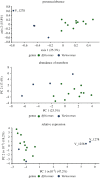Comparative transcriptomics of the venoms of continental and insular radiations of West African cones
- PMID: 32546094
- PMCID: PMC7329046
- DOI: 10.1098/rspb.2020.0794
Comparative transcriptomics of the venoms of continental and insular radiations of West African cones
Abstract
The transcriptomes of the venom glands of 13 closely related species of vermivorous cones endemic to West Africa from genera Africonus and Varioconus were sequenced and venom repertoires compared within a phylogenetic framework using one Kalloconus species as outgroup. The total number of conotoxin precursors per species varied between 108 and 221. Individuals of the same species shared about one-fourth of the total conotoxin precursors. The number of common sequences was drastically reduced in the pairwise comparisons between closely related species, and the phylogenetical signal was totally eroded at the inter-generic level (no sequence was identified as shared derived), due to the intrinsic high variability of these secreted peptides. A common set of four conotoxin precursor superfamilies (T, O1, O2 and M) was expanded in all studied cone species, and thus, they are considered the basic venom toolkit for hunting and defense in the West African vermivorous cone snails. Maximum-likelihood ancestral character reconstructions inferred shared conotoxin precursors preferentially at internal nodes close to the tips of the phylogeny (between individuals and between closely related species) as well as in the common ancestor of Varioconus. Besides the common toolkit, the two genera showed significantly distinct catalogues of conotoxin precursors in terms of type of superfamilies present and the abundance of members per superfamily, but had similar relative expression levels indicating functional convergence. Differential expression comparisons between vermivorous and piscivorous cones highlighted the importance of the A and S superfamilies for fish hunting and defense.
Keywords: Africonus; Varioconus; conotoxin precursors; transcriptomes; vermivorous cones.
Conflict of interest statement
The authors declare no competing interests.
Figures




References
-
- Tucker JK, Tenorio MJ. 2009. Systematic classification of recent and fossil conoidean gastropods, with keys to the genera of cone shells. Hackenheim, Germany: ConchBooks.
Publication types
MeSH terms
Substances
Associated data
LinkOut - more resources
Full Text Sources

